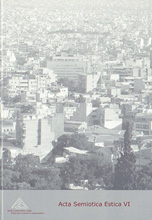Grupiportree kunstiline struktuur ja Velázqueze sacra conversazione “Las Meninas”
The artistic structure of group portrait and Velázquez’s sacra conversazione “Las Meninas”
Author(s): Linnar PriimägiSubject(s): Semiotics / Semiology
Published by: Eesti Semiootika Selts
Keywords: group portrait; artistic space; sacra conversazione; Velázquez; Las Meninas; grupiportree; kunstiline ruum; sacra conversazione; Velázquez;
Summary/Abstract: There are 3 degrees of likeness in portraiture: (F1) the type (the exponent of a social group — Arturo Martini’s “Sitting boy”), (F2) the character (the exponent of a psychological group — Guido Reni’s “Ecce homo”), (F3) the individuality (the unique person with a proper name — Velázquez’s “Innocent X”). There are 4 degrees of homogeneity of the internal space in the work of art, created by 5 kinds of activity: (H0) individual activities in separate spaces [ill. 1], (H1) parallel activities (human ornament [2, 3]), (H2) distantly combined activities creating loci (event areas) and marked compositions [4–6], (H3) common activities of participants in an integrative atmospheric and compositional locus [7, 13], (H4) joint activities as the mutual situational physical dependence. The group portrait in the European painting developed through spacial association of singular type and character portraits of Christian saints (H1 → H2). The sacra conversazione was the first completed form of it. It is a spacial assemblage of certain religious characters united by some collective parallel psychological activity (Latin conversari means ‘to deal with somebody’) and with vague loci boundaries (H1/H2). The best known example of it is the San Zaccaria altar piece by Giovanni Bellini [ill. 11]. The later development of sacra conversazione resulted in more and more homogeneous pictorial space [12, 13] and — because of the aesthetical antagonism between the portraiture and the grouping — ended in the retreat of individual portrait [F3 → (F2/F1)] in the genre painting [14]. Velázquez’s painting “Las Meninas” highlights the border between the collective loneliness of a sacra conversazione group (H1/H2) and its distantly combined activities in a concrete genre interior, a shared pictorial space (H3) with blurred loci borders in it. The depicted persons also tend to be more characterized than individualized. Thus, the artistic structure of “Las Meninas” could be described as: H3 {[(H1/H2) <> H2] + [F3 > (F2/F1)]}. It is impossible to analyze “Las Meninas” as a genre painting because it is not. It is a splendid example of sacra conversazione in the post-renaissance European art.
Journal: Acta Semiotica Estica
- Issue Year: 2009
- Issue No: 6
- Page Range: 133-153
- Page Count: 21
- Language: Estonian

